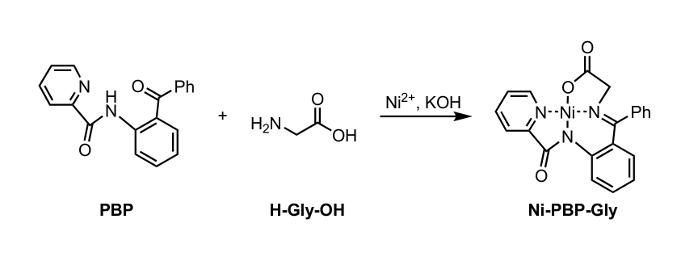镍 - 席夫碱的水解复杂环境条件适宜酸不稳定保护基团的保留
Summary
这里,我们提出一种有效的水解和从镍席夫碱配合物中分离的氨基酸的后续的Fmoc保护。是必需的酸不稳定侧链保护基团的保留时这里介绍的水解条件是适合使用的。这种技术可以适用于各种非天然氨基酸的衬底。
Abstract
非天然氨基酸,含有侧链官能自然界中不常见的氨基酸,正越来越多地在合成的肽序列中发现。某些非天然氨基酸的合成通常包括使用由通过镍阳离子稳定化的席夫碱的前体。非天然侧链可以安装在在该席夫碱配合物中发现的氨基酸主链。将所得的非天然氨基酸可随后从所述席夫碱的这种复杂的使用水解分离,典型地通过采用回流在强酸性溶液中。这些高酸性条件可除去对酸不稳定的侧链保护基团所需的用于向微波辅助固相肽合成中使用的非天然氨基酸。在这项工作中,我们提出了一种有效的水解和从镍席夫碱配合物中分离的氨基酸的后续的Fmoc保护。在这项工作中提出水解条件适合于酸不稳定S的保持IDE-侧链保护基,并且可以是适于多种非天然氨基酸的衬底。
Introduction
非天然氨基酸(UAA的)轴承侧链从那些在自然界中发现的20个天然存在的氨基酸的变化已经在广泛的应用范围中找到效用。这些UAA的合成,但是,可以根据侧链的结构和氨基酸主链的立体化学是困难的。在镍席夫碱络合物的情况下甘氨酸克·邦德活化已被用来生产多种氨基酸衍生物,包括α,β二氨基酸1和UAA的轴承氟化2或杂环侧链。 3
另外的非天然侧链后,官能UAA的典型地由在盐酸4通过回流席夫碱配合物中取出,使用离子交换色谱法,随后分离。虽然通常是有效,该协议生成美浓酸,可能是不适合用于固相肽合成(SPPS)的使用。 SPPS的性质要求酸不稳定侧链保护基团的存在和的典型镍席夫碱分解条件强酸性性质防止UAA的隔离用这些保护基团完整。据我们所知,只有一个选择分解方法已经报道了:使用乙二胺四乙酸(EDTA)和肼的在升高的温度下,5个条件本身可能不适合于某些侧链保护基团,例如邻苯二甲酰亚胺。

图1:选自Ni 2+,PBP,和甘氨酸(GLY)的Ni-PBP -甘氨酸的合成。 请点击此处查看该图的放大版本。 </一>
在本文中,我们报道了镍席夫碱配合物的水解的方法,镍- PBP -甘氨酸( 图1)。这种复杂的,选自Ni 2+,甘氨酸,和吡啶-2-羧酸(2-苯甲酰基苯基) -酰胺(PBP),6得出的已被证明是用于多种UAA的合成有用的平台,并容易访问使用两步合成路线。这种复杂的7种合成是文献先例的高收率。 6我们的研究结果如下所述证明利用EDTA中在温和的酸性至适合于与UAA的轴承酸不稳定侧链保护基团的使用中性pH条件的水解条件的适用性。水解之后,所得的水溶液可被分离,并立即进行标准Fmoc保护的条件,得到Fmoc-保护的氨基酸( 图2)。
<p class="jove_content" f○:保持-together.within页= "“1”">
图2:水解和氨基酸选自Ni-PBP -甘氨酸隔离的的Fmoc保护。反应条件:一。 EDTA(12当量),pH值4.5; II。乙酸乙酯洗涤并调整至pH 7; III。将Fmoc-OSu的(1当量), 碳酸氢钠 (2当量)。 请点击此处查看该图的放大版本。
Protocol
Representative Results
Discussion
上述方案是在其通过两个关键步骤,以便于从温和的pH条件和此分离的氨基酸的后续的Fmoc保护下的Ni席夫碱配合物的氨基酸主链的隔离能力是有用的。第一步包括搅拌含有EDTA以促进从复合物中的氨基酸的释放的DMF /水的溶液。残余络合物或有机副产物可以容易地与萃取除去。本协议的第二步骤包括在第一步骤中通过萃取水层中的发现在分离后的氨基酸的Fmoc基保护。我们已经证明修改的pH范围4.5-7.5?…
Declarações
The authors have nothing to disclose.
Acknowledgements
通过滑岩大学提供资助。我们要感谢T·博龙III(滑岩大学)和C·哈尼(宾夕法尼亚大学),他们的见解。
Materials
| Ni-PBP-Gly | Synthesized from published protocol | ||
| DMF | Fisher | D119-4 | |
| EDTA | Fisher | S311-100 | |
| Dichloromethane | Acros | AC610050040 | |
| Sodium Bicarbonate | Fisher | S233-500 | |
| Fmoc-OSu | Chem-Impex | "00147" | |
| Dioxane | Fisher | D111-500 | |
| Hydrochloric Acid | Fisher | A144-500 | |
| Ethyl Acetate | Acros | AC610060040 | |
| Magnesium Sulfate | Fisher | M65-500 | |
| ZEOPrep 60ECO Silica Gel | ZEOChem | ||
| Hexanes | Fisher | 3200250.650.443 | |
| Chromatography Column | |||
| pH Test Strips | |||
| Rotary Evaporator | |||
| 250 mL Separatory Funnel | |||
| 250 mL Round Bottom Flask | |||
| Stir Bar | |||
| Stir Plate |
Referências
- Wang, J., Shi, T., Deng, G., Jiang, H., Liu, H. Highly Enantio- and Diastereoselective Mannich Reactions of Chiral Ni(II) Glycinates with amino sulfones. Efficient asymmetric synthesis of aromatic α,β-diamino acids. J. Org. Chem. 73 (21), 8563-8570 (2011).
- Wang, J., Lin, D., Zhou, S., Ding, X., Soloshonok, V. A., Liu, H. Asymmetric synthesis of sterically and electronically demanding linear ω,-trifluoromethyl containing amino acids via alkylation of chiral equivalents of nucleophilic glycine and alanine. J. Org. Chem. 76 (2), 684-687 (2011).
- Wang, J., Zhou, S., Lin, D., Ding, X., Jiang, H., Liu, H. Highly diastereo- and enantioselective synthesis of syn-β,-substituted tryptophans via asymmetric Michael addition of a chiral equivalent of nucleophilic glycine and sulfonylindoles. Chem. Commun. 47 (29), 8355-8357 (2011).
- Belokon, Y. N. Highly efficient catalytic synthesis of α,-amino acids under phase-transfer conditions with a novel catalyst/substrate pair. Angew. Chem. Int. Ed. 40 (10), 1948-1951 (2001).
- Zhou, S., Wang, J., Lin, D., Zhao, F., Liu, H. Enantioselective synthesis of 2-substituted-tetrahydroisoquinolin-1-yl glycine derivatives via oxidative cross-dehydrogenative coupling of tertiary amines and chiral nickel(II) glycinate. J. Org. Chem. 78 (22), 11204-11212 (2013).
- Belokon, Y. N. Synthesis of α,-amino acids via asymmetric phase transfer-catalyzed alkylation of achiral nickel(II) complexes of glycine-derived Schiff bases. J. Am. Chem. Soc. 125 (42), 12860-12871 (2003).
- Ueki, H., Ellis, T. K., Martin, C. H., Soloshonok, V. A. Efficient large-scale synthesis of picolinic acid-derived nickel(II) complexes of glycine. Eur. J. Org. Chem. 2003 (10), 1954-1957 (2003).
- Dener, J. M., Fantauzzi, P. P., Kshirsagar, T. A., Kelly, D. E., Wolfe, A. B. Large-scale syntheses of Fmoc-protected non-proteogenic amino acids: useful building blocks for combinatorial libraries. Org. Process Res. Dev. 5 (4), 445-449 (2001).
- Cruz, L. J., Beteta, N. G., Ewenson, A., Albericio, F. "One-pot", preparation of N-carbamate protected amino acids via the azide. Org Process Res. Dev. 8 (6), 920-924 (2004).
- Hart, J. R. . Ullmann’s Encyclopedia of Industrial Chemistry. , (2000).
- Adamson, J. G., Blaskovich, M. A., Groenevelt, H., Lajoie, G. A. Simple and convenient synthesis of tert-butyl ethers of Fmoc-serine, Fmoc-threonine, and Fmoc-tyrosine. J. Org. Chem. 56 (10), 3447-3449 (1991).
- Seyfried, M. S., Lauber, B. S., Luedtke, N. W. Multiple-turnover isotopic labeling of Fmoc- and Boc-protected amino acids with oxygen isotopes. Org. Lett. 12 (1), 104-106 (2010).
- Bonke, G., Vedel, L., Witt, M., Jaroszewski, J. W., Olsen, C. A., Franzyk, H. Dimeric building blocks for solid-phase synthesis of α,-peptide-β,-peptoid chimeras. Synthesis. 2008 (15), 2381-2390 (2008).

